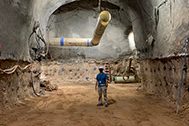Construction of the testbed that will host the Advanced Sources and Detectors (ASD) Scorpius machine and its associated tunnels continues 963 feet below ground surface at the NNSS U1a Complex.
Scorpius will enable experiments that image special nuclear material during multiple stages of detonation in order to provide essential data on stockpile safety and certification, while still being subcritical and designed to never reach criticality. Upon completion in 2025, Scorpius will be the most capable weapons radiographic system in the world.
The tunnel infrastructure buildout project, titled the Underground Complex Enhancement Project, or UCEP, will provide space, infrastructure and support facilities to expand the NNSS’ Enhanced Capabilities for Subcritical Experiments (ECSE) efforts. Upon completion, NNSS will be able to provide important performance information not available today.
Mining tunnels nearly 1,000 feet underground in the Southern Nevada bedrock presents unique opportunities for innovation not typically encountered in other large-scale projects.
In March of 2021, the U1a Complex hit a major milestone as staff punched through the last remaining dirt wall between the two halves of the new tunnel. While tunnels are typically dug beginning at one end and going clean through to the other, the NNSS team determined the process could be done equally as well, but in a timelier manner, by beginning drilling at two ends of the tunnel simultaneously. Crews headed toward each other and eventually met in the middle.
Another unique, upcoming challenge the team has already begun solving: pumping a large amount of concrete more than 1,200 feet to complete a total placement exceeding 2,000 cubic yards.
When most people think of mixing up some concrete, a trip to the nearest hardware store for a bag of dry ingredients to be combined with water from the backyard hose likely comes to mind. And while that may, indeed, be just what’s needed for most household DIY projects, the possible ingredient ratios for mixing cement are surprisingly limitless.
“Concrete is as varied as different cake mixes,” said NNSS Supervisor David Glass, a member of Mission Assurance’s Quality Services & Support/Contractor Assurance System team.
Essentially, it’s a science.
The main components of concrete are 3/4-inch aggregate rock, 3/8-inch aggregate, sand, 1/4-inch aggregate rock, cement material and fly ash. However, ratios of these ingredients can vary based on use, transport and other factors. Fly ash, for example, creates added strength in concrete, while added retardants delay the concrete’s ability to set for a certain amount of time. When looking at pumpability over a great distance, a higher slump—more moisture in the cement to water ratio—is important, as the concrete begins to lose moisture as it’s pumped. However, the moisture must not be so high that the materials segregate—with the heavier materials sinking to the bottom—which would mean a quicker deterioration of the concrete over time.
To select just the right mixture, the team partnered with Jacobs, one of the three joint venture partner companies that make up NNSS management and operating contractor Mission Support and Test Services LLC.
Over the course of 11 weeks, the NNSS Material Testing Laboratory (MTL)—utilizing technology and equipment introduced in partnership with the Enterprise Infrastructure Programs team—supported and delivered analyses of 33 trial mix designs provided by Jacobs for testing and produced eight complete mix designs.
For each design, the MTL team fed a 2.7-yard mix into a small lab concrete mixer. They analyzed each mixture for air, slump, unit weight, compressive strength, air entrainment (critical for certain conditions and helps with pumpability) and more. They then created a series of 12 test cylinders per mix to be broken for compression strength testing at various stages of the drying process to see whether the mix design would function as desired.
Concrete gains strength as it ages. It’s technically supposed to be cured at 28 days, which is the American Society for Testing and Materials standard, but that’s not always the case. The MTL team broke three cylinders at seven days, three at 14 days, three at 28 days and three at 56 days, with all results reported back to Jacobs for ongoing discussion and collaboration.
“It was an undertaking,” Glass said.
After analysis was completed on each of the eight that moved forward to full truck trial batches, the NNSS used the materials for other projects they had going, so no materials were wasted.
In the coming months, the mixes identified as workable will be blended into full-size trial batches and pumped underground at U1a for testing. Again, the material won’t go to waste, as concrete is regularly used underground anyway for dust control as the tunnels are dug out.
While extensive, the test process lays the groundwork for a proven, stable design consistent among batch-to-batch results.
“The partnership with Construction is the special ingredient,” said Quality Services and Support/CAS Director David Martin. “Great partnerships produce great results and are the foundation for the work going forward.”
A recently upgraded full concrete and soils laboratory, the NNSS Material Testing Laboratory is integral to projects throughout the Site, including the buildout for Scorpius. The lab professionals regularly perform proctor compaction testing to determine what it takes to make soil fully compacted before concrete is placed, thus ensuring concrete doesn’t crack or sag later due to ground settling. They also test and inspect trenching and storm drains and conduct building and welding inspections across the Site, protecting the people, property and buildings and ensuring the NNSS can carry out its critical national security mission.

